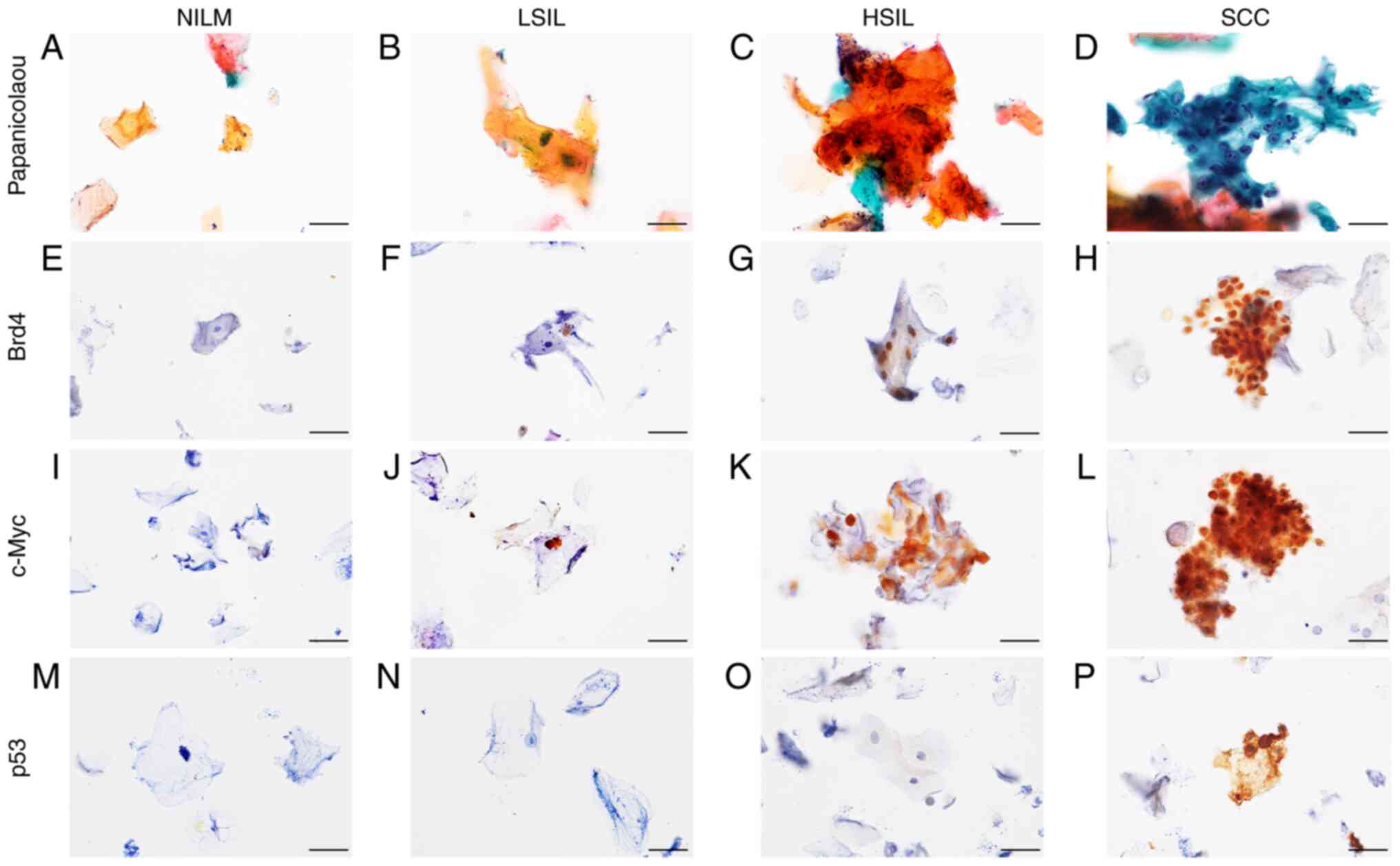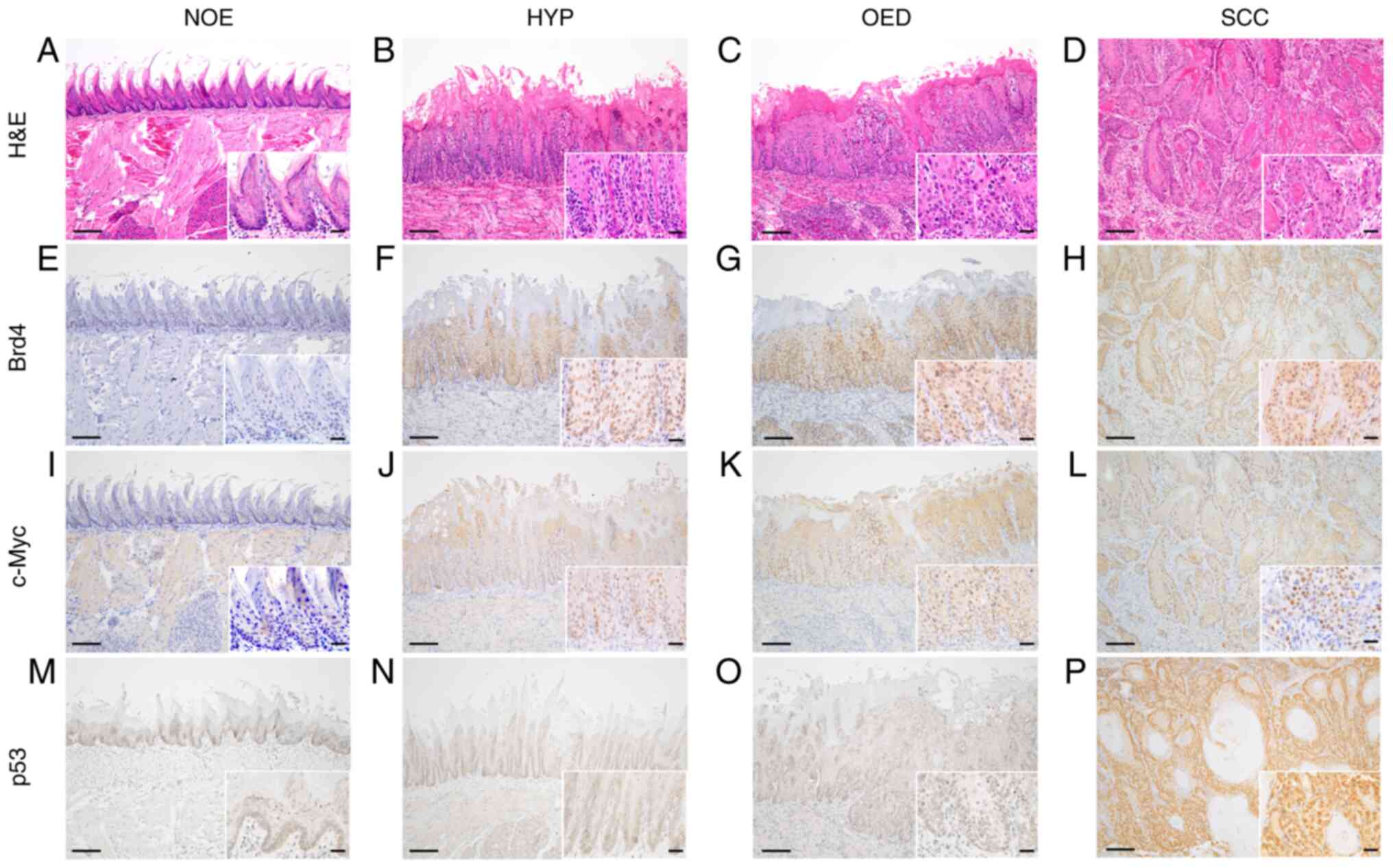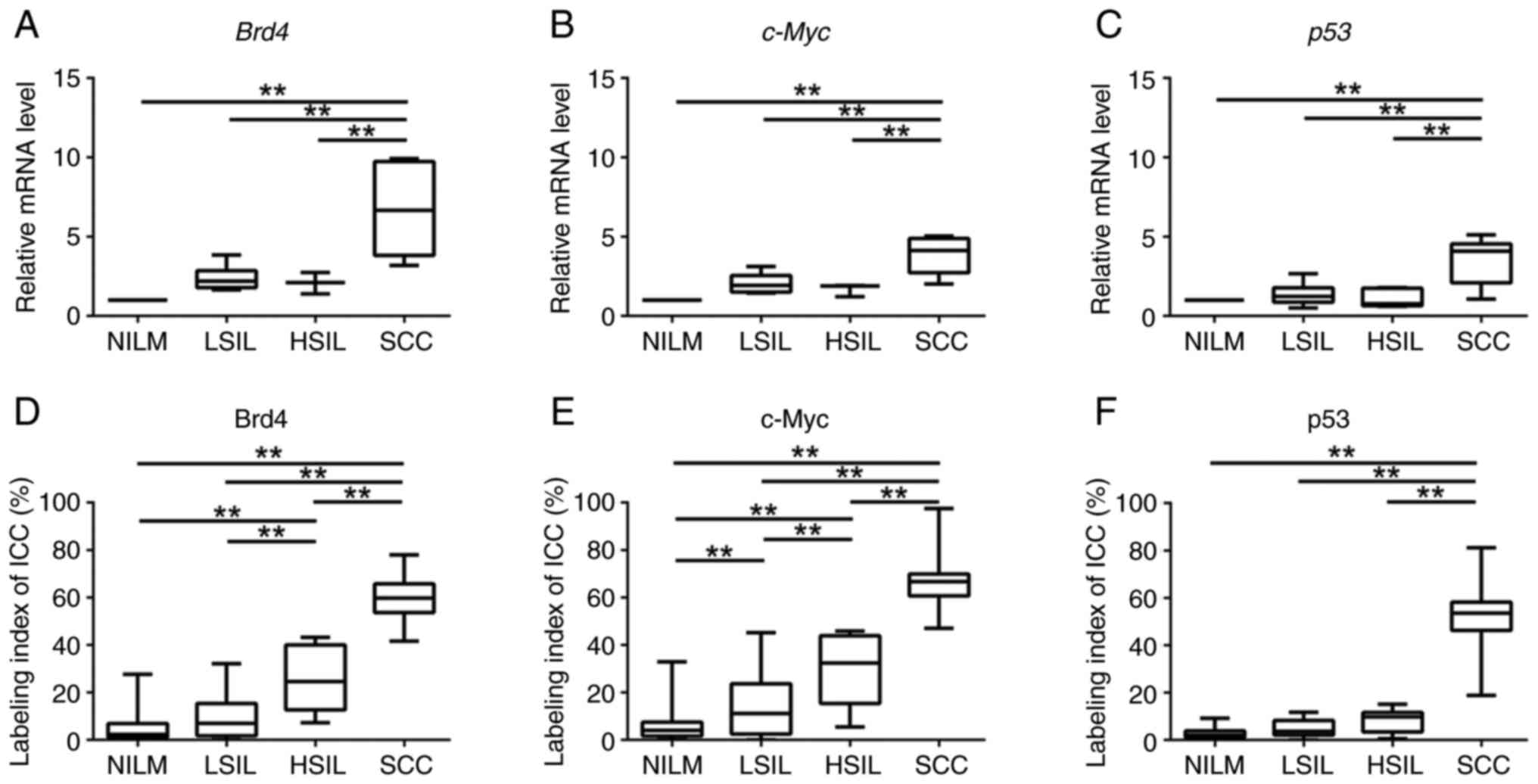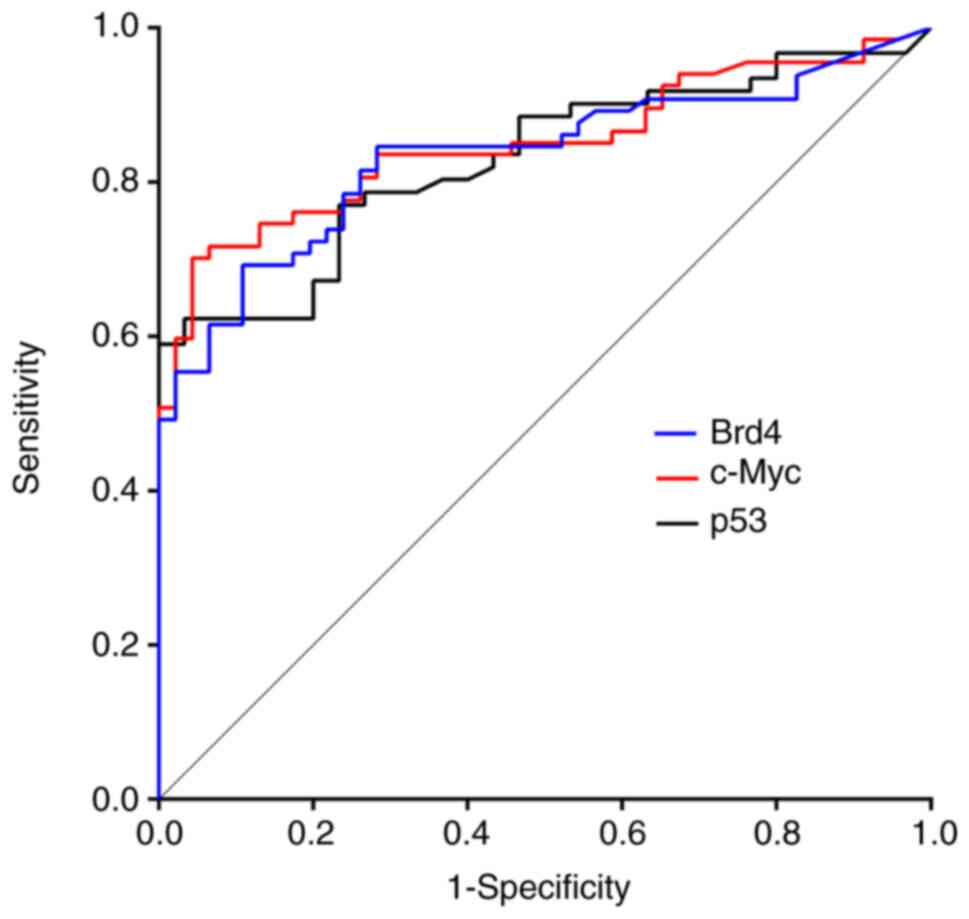|
1
|
El-Naggar AK, Chan JKC, Grandis JR, Takata
T and Slootweg PJ: World Health Organization classification of Head
and Neck Tumours. 9. 4th edition. IARC Press; Lyon: pp. 109–111.
2017
|
|
2
|
Bray F, Ferlay J, Soerjomataram I, Siegel
RL, Torre LA and Jemal A: Global cancer statistics 2018: GLOBOCAN
estimates of incidence and mortality worldwide for 36 cancers in
185 countries. CA Cancer J Clin. 68:394–424. 2018. View Article : Google Scholar : PubMed/NCBI
|
|
3
|
Miranda-Filho A and Bray F: Global
patterns and trends in cancers of the lip, tongue and mouth. Oral
Oncol. 102:1045512020. View Article : Google Scholar : PubMed/NCBI
|
|
4
|
Tirelli G, Gatto A, Bonini P, Tofanelli M,
Arnež ZM and Piccinato A: Prognostic indicators of improved
survival and quality of life in surgically treated oral cancer.
Oral Surg Oral Med Oral Pathol Oral Radiol. Jan 31–2018.(Epub ahead
of print). doi: 10.1016/j.oooo.2018.01.016. View Article : Google Scholar : PubMed/NCBI
|
|
5
|
Blatt S, Krüger M, Ziebart T, Sagheb K,
Schiegnitz E, Goetze E, Al-Nawas B and Pabst AM: Biomarkers in
diagnosis and therapy of oral squamous cell carcinoma: A review of
the literature. J Craniomaxillofac Surg. 45:722–730. 2017.
View Article : Google Scholar : PubMed/NCBI
|
|
6
|
Omar E: Current concepts and future of
noninvasive procedures for diagnosing oral squamous cell
carcinoma-a systematic review. Head Face Med. 11:62015. View Article : Google Scholar : PubMed/NCBI
|
|
7
|
Osaka R, Hayashi K, Onda T, Shibahara T
and Matsuzaka K: Evaluation of liquid based cytology for tongue
squamous cell carcinoma: Comparison with conventional cytology.
Bull Tokyo Dent Coll. 60:29–37. 2019. View Article : Google Scholar : PubMed/NCBI
|
|
8
|
Kujan O, Huang G, Ravindran A, Vijayan M
and Farah CS: CDK4, CDK6, cyclin D1 and Notch1 immunocytochemical
expression of oral brush liquid-based cytology for the diagnosis of
oral leukoplakia and oral cancer. J Oral Pathol Med. 48:566–573.
2019. View Article : Google Scholar : PubMed/NCBI
|
|
9
|
Sivakumar N, Narwal A, Kumar S, Kamboj M,
Devi A, Pandiar D and Bhardwaj R: Application of the Bethesda
system of reporting for cervical cytology to evaluate human
papilloma virus induced changes in oral leukoplakia, oral squamous
cell carcinoma, and oropharyngeal squamous cell carcinoma: A
cytomorphological and genetic study. Diagn Cytopathol.
49:1036–1044. 2021. View
Article : Google Scholar : PubMed/NCBI
|
|
10
|
Rossi ED, Bizzarro T, Schmitt F and
Longatto-Filho A: The role of liquid-based cytology and ancillary
techniques in pleural and pericardic effusions: An institutional
experience. Cancer Cytopathol. 123:258–266. 2015. View Article : Google Scholar : PubMed/NCBI
|
|
11
|
Mehrotra R: The role of cytology in oral
lesions: A review of recent improvements. Diagn Cytopathol.
40:73–83. 2012. View
Article : Google Scholar : PubMed/NCBI
|
|
12
|
Tanuma JI, Shisa H, Hiai H, Higashi S,
Yamada Y, Kamoto T, Hirayama Y, Matsuuchi H and Kitano M:
Quantitative trait loci affecting 4-nitroquinoline 1-oxide-induced
tongue carcinogenesis in the rat. Cancer Res. 58:1660–1664.
1998.PubMed/NCBI
|
|
13
|
Tanuma JI, Kitano M, Shisa H and Hiai H:
Polygenetic susceptibility and resistance to 4-nitroquinoline
1-oxide-induced tongue carcinomas in the rat. J Exp Anim Sci.
41:68–77. 2000. View Article : Google Scholar
|
|
14
|
Tanuma JI, Hiai H, Shisa H, Hirano M,
Semba I, Nagaoka S and Kitano M: Carcinogenesis modifier loci in
rat tongue are subject to frequent loss of heterozygosity. Int J
Cancer. 102:638–642. 2002. View Article : Google Scholar : PubMed/NCBI
|
|
15
|
Tanuma JI, Fujii K, Hirano M, Matsuuchi H,
Shisa H, Hiai H and Kitano M: Five quantitative trait loci
affecting 4-nitroquinoline 1-oxide-induced tongue cancer in the
rat. Jpn J Cancer Res. 92:610–616. 2001. View Article : Google Scholar : PubMed/NCBI
|
|
16
|
Suwa H, Hirano M, Kawarada K, Nagayama M,
Ehara M, Muraki T, Shisa H, Sugiyama A, Sugimoto M, Hiai H, et al:
Pthlh, a promising cancer modifier gene in rat tongue
carcinogenesis. Oncol Rep. 31:3–12. 2014. View Article : Google Scholar : PubMed/NCBI
|
|
17
|
Zuber J, Shi J, Wang E, Rappaport AR,
Herrmann H, Sison EA, Magoon D, Qi J, Blatt K, Wunderlich M, et al:
RNAi screen identifies Brd4 as a therapeutic target in acute
myeloid leukaemia. Nature. 478:524–528. 2011. View Article : Google Scholar : PubMed/NCBI
|
|
18
|
Wu Y, Wang Y, Diao P, Zhang W, Li J, Ge H,
Song Y, Li Z, Wang D, Liu L, et al: Therapeutic targeting of BRD4
in head neck squamous cell carcinoma. Theranostics. 9:1777–1793.
2019. View Article : Google Scholar : PubMed/NCBI
|
|
19
|
Lovén J, Hoke HA, Lin CY, Lau A, Orlando
DA, Vakoc CR, Bradner JE, Lee TI and Young RA: Selective inhibition
of tumor oncogenes by disruption of super-enhancers. Cell.
153:320–334. 2013. View Article : Google Scholar : PubMed/NCBI
|
|
20
|
Liu X, Li Q, Huang P, Tong D, Wu H and
Zhang F: EGFR-mediated signaling pathway influences the sensitivity
of oral squamous cell carcinoma to JQ1. J Cell Biochem.
119:8368–8377. 2018. View Article : Google Scholar : PubMed/NCBI
|
|
21
|
Zhao L, Li P, Zhao L, Wang M, Tong D, Meng
Z, Zhang Q, Li Q and Zhang F: Expression and clinical value of
PD-L1 which is regulated by BRD4 in tongue squamous cell carcinoma.
J Cell Biochem. 121:1855–1869. 2020. View Article : Google Scholar : PubMed/NCBI
|
|
22
|
Cho HY, Lee SW, Jeon YH, Lee DH, Kim GW,
Yoo J, Kim SY and Kwon SH: Combination of ACY-241 and JQ1
synergistically suppresses metastasis of HNSCC via regulation of
MMP-2 and MMP-9. Int J Mol Sci. 21:68732020. View Article : Google Scholar : PubMed/NCBI
|
|
23
|
Yamamoto T, Hirosue A, Nakamoto M, Yoshida
R, Sakata J, Matsuoka Y, Kawahara K, Nagao Y, Nagata M, Takahashi
N, et al: BRD4 promotes metastatic potential in oral squamous cell
carcinoma through the epigenetic regulation of the MMP2 gene. Br J
Cancer. 123:580–590. 2020. View Article : Google Scholar : PubMed/NCBI
|
|
24
|
Delmore JE, Issa GC, Lemieux ME, Rahl PB,
Shi J, Jacobs HM, Kastritis E, Gilpatrick T, Paranal RM, Chesi M,
et al: BET bromodomain inhibition as a therapeutic strategy to
target c-Myc. Cell. 146:904–917. 2011. View Article : Google Scholar : PubMed/NCBI
|
|
25
|
Poter JR, Fisher BE, Baranello L, Liu JC,
Kambach DM, Nie Z, Koh WS, Luo J, Stommel JM, Levens D and
Batchelor E: Global inhibition with specific activation: How p53
and MYC redistribute the transcriptome in the DNA double-strand
break response. Mol Cell. 67:1013–1025. 2017. View Article : Google Scholar : PubMed/NCBI
|
|
26
|
Ries JC, Schreiner D, Steininger H and
Girod SC: p53 mutation and detection of p53 protein expression in
oral leukoplakia and oral squamous cell carcinoma. Anticancer Res.
18:2031–2036. 1998.PubMed/NCBI
|
|
27
|
Pallavi N, Nalabolu GRK and Hiremath SKS:
Bcl-2 and c-Myc expression in oral dysplasia and oral squamous cell
carcinoma: An immunohistochemical study to assess tumor
progression. J Oral Maxillofac Pathol. 22:325–331. 2018. View Article : Google Scholar : PubMed/NCBI
|
|
28
|
Pérez-Sayáns M, Suárez-Peñaranda JM, Pilar
G, Barros-Angueira F, Gándara-Rey JM and García-garcía A: What real
influence does the proto-oncogene c-myc have in OSCC behavior? Oral
Oncol. 47:688–692. 2011. View Article : Google Scholar : PubMed/NCBI
|
|
29
|
Papakosta V, Vairaktaris E, Vylliotis A,
Derka S, Nkenke E, Vassiliou S, Lazaris A, Mourouzis C, Rallis G,
Spyridonidou S, et al: The co-expression of c-myc and p53 increases
and reaches a plateau early in oral oncogenesis. Anticancer Res.
26:2957–2962. 2006.PubMed/NCBI
|
|
30
|
Norimatsu Y, Yamaguchi T, Taira T, Abe H,
Sakamoto H, Takenaka M, Yanoh K, Yoshinobu M, Irino S, Hirai Y and
Kobayashi TK: Inter-observer reproducibility of endometrial
cytology by the osaki study group method: utilising the becton
dickinson surepath™ liquid-based cytology. Cytopathology.
27:472–478. 2016. View Article : Google Scholar : PubMed/NCBI
|
|
31
|
Suzuki T, Isaka E, Hiraga C, Akiyama Y,
Okamura M, Oomura Y, Hashimoto K, Sato K, Tanaka Y and Nomura T:
New oral cytodiagnostic criteria predict change to oral epithelial
dysplasia (OED) and cancerization. Oral Sci Int. 18:203–208. 2021.
View Article : Google Scholar
|
|
32
|
Ogawa K, Tanuma JI, Hirano M, Hirayama Y,
Semba I, Shisa H and Kitano M: Selective loss of resistant alleles
at p15INK4B and p16INK4A genes in chemically-induced rat tongue
cancers. Oral Oncol. 42:710–717. 2006. View Article : Google Scholar : PubMed/NCBI
|
|
33
|
Livak KJ and Schmittgen TD: Analysis of
relative gene expression data using real-time quantitative PCR and
the 2(−Delta Delta C(T)) method. Methods. 25:402–408. 2001.
View Article : Google Scholar : PubMed/NCBI
|
|
34
|
Robin X, Turck N, Hainard A, Tiberti N,
Lisacek F, Sanchez JC and Müller M: pROC: An open-source package
for R and S+ to analyze and compare ROC curves. BMC Bioinformatics.
12:772011. View Article : Google Scholar : PubMed/NCBI
|
|
35
|
Kitano M: Host genes controlling the
susceptibility and resistance to squamous cell carcinoma of the
tongue in a rat model. Pathol Int. 50:353–362. 2000. View Article : Google Scholar : PubMed/NCBI
|
|
36
|
Kanojia D and Vaidya MM:
4-Nitroquinoline-1-oxide induced experimental oral carcinogenesis.
Oral Oncol. 42:655–667. 2006. View Article : Google Scholar : PubMed/NCBI
|
|
37
|
Moon SM, Ahn MY, Kwon SM, Kim SA, Ahn SG
and Yoon JH: Homeobox C5 expression is associated with the
progression of 4-nitroquinoline 1-oxide-induced rat tongue
carcinogenesis. J Oral Pathol Med. 41:470–476. 2012. View Article : Google Scholar : PubMed/NCBI
|
|
38
|
Arduino PG, Surace A, Carbone M, Elia A,
Massolini G, Gandolfo S and Broccoletti R: Outcome of oral
dysplasia: A retrospective hospital-based study of 207 patients
with a long follow-up. J Oral Pathol Med. 38:540–544. 2009.
View Article : Google Scholar : PubMed/NCBI
|
|
39
|
Ikeda M, Shima K, Kondo T and Semba I:
Atypical immunohistochemical patterns can complement the
histopathological diagnosis of oral premalignant lesions. J Oral
Biosci. 62:93–98. 2020. View Article : Google Scholar : PubMed/NCBI
|
|
40
|
Noda Y, Kondo Y, Sakai M, Sato S and
Kishino M: Galectin-1 is a useful marker for detecting neoplastic
squamous cells in oral cytology smears. Hum Pathol. 52:101–109.
2016. View Article : Google Scholar : PubMed/NCBI
|
|
41
|
Osugi Y: p53 expression in various stages
of 4-nitroquinoline 1-oxide induced carcinoma in the rat tongue. J
Osaka Dent Univ. 30:29–35. 1996.PubMed/NCBI
|
|
42
|
Li S, Zhang S and Chen J: c-Myc induced
upregulation of long non-coding RNA SNHG16 enhances progression and
carcinogenesis in oral squamous cell carcinoma. Cancer Gene Ther.
26:400–410. 2019. View Article : Google Scholar : PubMed/NCBI
|
|
43
|
Ota K, Fujimori H, Ueda M, Jono H,
Shinriki S, Ota T, Sueyoshi T, Taura M, Taguma A, Kai H, et al:
Midkine expression is correlated with an adverse prognosis and is
down-regulated by p53 in oral squamous cell carcinoma. Int J Oncol.
37:797–804. 2010.PubMed/NCBI
|
|
44
|
Loke SL, Neckers LM, Schwab G and Jaffe
ES: c-myc protein in normal tissue. Effects of fixation on its
apparent subcellular distribution. Am J Pathol. 131:29–37.
1988.PubMed/NCBI
|
|
45
|
Lee CM: Transport of c-MYC by Kinesin-1
for proteasomal degradation in the cytoplasm. Biochim Biophys Acta.
1843:2027–2036. 2014. View Article : Google Scholar : PubMed/NCBI
|
|
46
|
Pérez-Sayáns M, Suárez-Peñaranda JM,
Padín-Iruegas E, Gayoso-Diz P, Reis-De Almeida M, Barros-Angueira
F, Gándara-Vila P, Blanco-Carrión A and García-García A:
Quantitative determination of c-myc facilitates the assessment of
prognosis of OSCC patients. Oncol Rep. 31:1677–1682. 2014.
View Article : Google Scholar : PubMed/NCBI
|
|
47
|
Bouchard C, Dittrich O, Kiermaier A,
Dohmann K, Menkel A, Eilers M and Lüscher B: Regulation of cyclin
D2 gene expression by the Myc/Max/Mad network: Myc-dependent TRRAP
recruitment and histone acetylation at the cyclin D2 promoter.
Genes Dev. 15:2042–2047. 2001. View Article : Google Scholar : PubMed/NCBI
|
|
48
|
Tumbarello DA and Turner CE: Hic-5
contributes to epithelial-mesenchymal transformation through a
RhoA/ROCK-dependent pathway. J Cell Physiol. 211:736–747. 2007.
View Article : Google Scholar : PubMed/NCBI
|
|
49
|
Hermeking H, Rago C, Schuhmacher M, Li Q,
Barrett JF, Obaya AJ, O'Connell BC, Mateyak MK, Tam W, Kohlhuber F,
et al: Identification of CDK4 as a target of c-MYC. Proc Natl Acad
Sci USA. 97:2229–2234. 2000. View Article : Google Scholar : PubMed/NCBI
|
|
50
|
Yap CS, Peterson AL, Castellani G, Sedivy
JM and Neretti N: Kinetic profiling of the c-Myc transcriptome and
bioinformatic analysis of repressed gene promoters. Cell Cycle.
10:2184–2196. 2011. View Article : Google Scholar : PubMed/NCBI
|
|
51
|
Claassen GF and Hann SR: A role for
transcriptional repression of p21CIP1 by c-Myc in overcoming
transforming growth factor β-induced cell-cycle arrest. Proc Natl
Acad Sci USA. 97:9498–9503. 2000. View Article : Google Scholar : PubMed/NCBI
|
|
52
|
Acosta JC, Ferrándiz N, Bretones G,
Torrano V, Blanco R, Richard C, O'Connell B, Sedivy J, Delgado MD
and León J: Myc inhibits p27-induced erythroid differentiation of
leukemia cells by repressing erythroid master genes without
reversing p27-mediated cell cycle arrest. Mol Cell Biol.
28:7286–7295. 2008. View Article : Google Scholar : PubMed/NCBI
|
|
53
|
Waitzberg AF, Nonogaki S, Nishimoto IN,
Kowalski LP, Miguel RE, Brentani RR and Brentani MM: Clinical
significance of c-myc and p53 expression in head and neck squamous
cell carcinomas. Cancer Detect Prev. 28:178–186. 2004. View Article : Google Scholar : PubMed/NCBI
|
|
54
|
Ribeiro DA, Kitakawa D, Aparecida M,
Domingues C, Cabral LAG, Marques MEA and Salvadori DMF: Survivin
and inducible nitric oxide synthase production during 4NQO-induced
rat tongue carcinogenesis: A possible relationship. Exp Mol Pathol.
83:131–137. 2007. View Article : Google Scholar : PubMed/NCBI
|
|
55
|
Vlajnic T, Savic S, Barascud A, Baschiera
B, Bihl M, Grilli B, Herzog M, Rebetez J and Bubendorf L: Detection
of ROS1-positive non-small cell lung cancer on cytological
specimens using immunocytochemistry. Cancer Cytopathol.
126:421–429. 2018. View Article : Google Scholar : PubMed/NCBI
|
|
56
|
Nakra T, Nambirajan A, Guleria P, Phulware
RH and Jain D: Insulinoma-associated protein 1 is a robust nuclear
immunostain for the diagnosis of small cell lung carcinoma in
cytology smears. Cancer Cytopathol. 127:539–548. 2019. View Article : Google Scholar : PubMed/NCBI
|
|
57
|
Jain D, Nambirajan A, Borczuk A, Chen G,
Minami Y, Moreira AL, Motoi N, Papotti M, Rekhtman N, Russell PA,
et al: Immunocytochemistry for predictive biomarker testing in lung
cancer cytology. Cancer Cytopathol. 127:325–339. 2019. View Article : Google Scholar : PubMed/NCBI
|
|
58
|
Metovic J, Righi L, Delsedime L, Volante M
and Papotti M: Role of immunocytochemistry in the cytological
diagnosis of pulmonary tumors. Acta Cytol. 64:16–29. 2020.
View Article : Google Scholar : PubMed/NCBI
|
|
59
|
Tone K, Ohno S, Honda M, Notsu A, Sasaki K
and Sugino T: Application of enhancer of zeste homolog 2
immunocytochemistry to bile cytology. Cancer Cytopathol.
129:612–621. 2021. View Article : Google Scholar : PubMed/NCBI
|



















